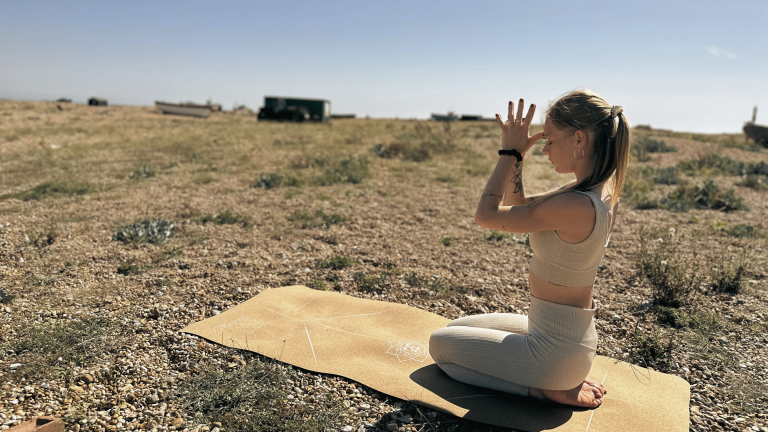Mindful Yoga: 4 Ideas to Inspire Your Students Through Mindful Yoga Classes
Good on you! You are looking to grow as a yoga teacher – or otherwise you would not be here, reading this article 😊
The truth is, there are many ways to go about creating, sequencing, and teaching yoga classes. Of course, a lot of this has to do with the style you teach. As an Ashtanga Yoga teacher or a Rocket® teacher, you do not require creative sequencing, for example.
However, no matter what style or type of yoga you practice, all classes can be made “mindful”. Another way of looking at this is to think of creating ‘holistic’ yoga classes beyond the mere physical poses.
In this article, we will explore the importance of mindful class themes, share practical tips to create inspiring themes, and discuss how they can help you engage your students and create meaningful yoga experiences.

Understanding the Power of Mindful Class Themes
A mindful class theme acts as the foundation for your yoga classes, shaping the overall experience for your students. It goes beyond the physical practice of asanas and helps create a deeper connection between the mind, body, and soul energy. By choosing and integrating a meaningful theme, you can guide your students to explore and reflect on various aspects of their practice, encouraging a deeper connection on and off the mat.
Crafting Mindful Yoga Class Themes
The themes you choose for your yoga classes can help you create mindfulness and a holistic approach to the yoga practice. If your theme is, for example, centred around surrendering and releasing, you can allow your students to practice this within their asana practice, as well as take these practices of the mat for their daily lives.
Here are a few pointers for crafting mindful yoga class themes:
1. Reflect on your intention
Begin by reflecting on your own intentions as a teacher. What message do you want to convey? What personal experiences or values can you draw upon to inspire your students? Aligning your theme with your intention will give your classes a sense of authenticity and purpose.
2. Consider your students’ needs
Take into account the unique needs and desires of your students. Are they seeking stress relief, inner peace, physical strength, or emotional healing? Tailor your themes to address these needs, holding a space for your students to explore their own journey.
3. Draw inspiration from life
Look to the world around you for inspiration. Nature, seasons, emotions, or philosophical concepts can serve as rich sources of themes. For example, you can explore themes of balance, gratitude, resilience, letting go, or self-compassion. Connect these themes to real-life experiences, making them relatable and accessible to your students.
4. Incorporate storytelling
Humans are natural storytellers and listeners. We connect with narratives that resonate with our own experiences or values. Weave stories into your classes, incorporating mythological tales, personal anecdotes, or even current events. This will capture your students’ attention and make your themes more engaging and memorable.
Check out my article Yoga Class Themes: Exploring 9 Possibilities to Theme a Yoga Class for nine cool ideas for theming and sequencing your classes!
Engaging Your Students on a Deeper Level
After crafting an inspiring and holistic theme to approach your yoga class, there are also a few things you can do as you guide your students through the practice to allow for a deeper experience in their practice.
1. Open with intention setting
To begin your class with intention setting, you can guide your students through a brief meditation or centering exercise. Let your students settle into a comfortable position – this can be seated, child’s pose, or even a reclined pose. Now invite them to close their eyes and take a few deep breaths. You can guide them to follow their breath, allowing their minds to focus on the breath and thereby creating more space between the thoughts.
Then, encourage them to set a personal intention for their practice, related to the class theme. For example, if your theme is “gratitude,” you might suggest intentions like “I cultivate gratitude for my body’s strength” or “I express gratitude for the present moment.”
By setting intentions, students become more mindful and purposeful in their practice, directing their energy and attention towards a specific focus. Throughout the class, provide moments of stillness, for example in a Downward Facing Dog or Child’s Pose, and remind your students of their intention. You can also do so again at the end of the practice, asking your students to invite their intention into their lives before closing the practice.
2. Cultivate reflection and inquiry
Throughout the class, create moments for students to reflect and inquire about their experiences. For instance, while guiding them through certain poses or transitions, or when returning to Downward Dog or Mountain Pose, pause and ask open-ended questions.
Examples could be:
- “Where can you release tension in this pose?”
- “Observe any thoughts that appear. What are they? Acknowledge them and let them move on.”
- “What sensations are coming up for you? Observe these with non-judgment.”
- “Where do YOU feel this pose?”
Encourage students to explore their internal landscape and also allow them to follow their inner guidance. This fosters self-awareness and mindfulness, and allows your students to deepens their connection with their practice and intuition.
Bonus tip: Encourage your students to keep a journal of their practices. They can either bring these to class and have a moment after their practice to write down any thoughts and observations, or they can do so when they get home.
3. Incorporate symbolism and visualisation
To integrate symbolism and visualisation, consider incorporating specific poses or mudras that align with your class theme. For instance, if your theme revolves around balance, guide students through a balancing sequence and encourage them to explore the concept of balance in their lives off the mat.
You can also use visualisation techniques to deepen their understanding of the theme. For example, during a relaxation pose like Savasana, guide students through a visualisation of a serene natural setting, inviting them to experience a sense of peace and tranquility. This visualisation helps them connect with the theme of inner calm and serenity.
4. Create a safe and inclusive space
Creating a safe and inclusive space is crucial for fostering deep engagement. Ensure that you use inclusive language and offer modifications and variations for different levels of practice. Notice your phrasing as teacher when guiding students into poses or transitions. You may want to avoid phrases such as “the full pose” or “go deeper”. Instead offer them different “options of a pose” and allow then to “explore the pose” or “notice sensations”.
Encourage students to listen to their bodies and honor their own boundaries. Implement a non-judgmental and accepting atmosphere by reminding students that yoga is a personal journey, and everyone’s practice is unique. This also ties in with how you phrase modifications and variations during the class. Lead by example and let the students know that „all poses are equal”, so they know that their practice is “complete”, even if their toes don’t lift off in Bakasana or they choose to skip Urdhva Danurasana.

As a yoga teacher, cultivating mindful class themes is a powerful tool that can help you inspire and engage your students on a deeper level. By carefully crafting themes that align with your intention and students’ needs, incorporating storytelling, and providing opportunities for reflection and inquiry, you create meaningful yoga experiences that go beyond the physical practice.
Remember, teaching yoga is about more than just guiding students through poses— it’s an opportunity to facilitate growth, self-discovery, and transformation, while holding a space for your students as they go on this journey.
Come say Hi on Instagram for more tips and inspiration!






